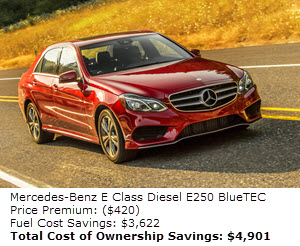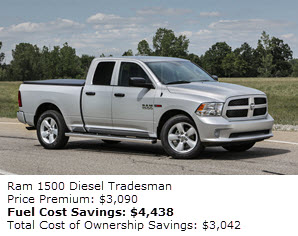 EXECUTIVE SUMMARY
EXECUTIVE SUMMARY
The Vincentric U.S. Diesel Analysis provides consumers and the automotive industry with information regarding the cost of owning a diesel vehicle compared to its closest all-gas counterpart. This year, results demonstrated that 55 of the total 356 diesels analyzed offered a lower total cost of ownership than their closest all-gasoline-powered equivalent. These 356 available diesel vehicles were categorized into three types: Passenger Cars (9 diesels), SUVs/Crossovers & Vans (75 diesels) and Pickup Trucks (272 diesels). Of the 55 cost-effective diesels, every one of the nine Passenger Car diesels showed lower total cost-of-ownership compared to their closest all-gasoline-powered counterparts. Other categories had less cost-effective diesels, with 36% in the SUVs/Crossovers & Vans category, and approximately 6% in the Pickup Trucks category.
DIESEL ANALYSIS
At Vincentric, we have prepared different analyses such as the Hybrid and Diesel Analyses in both U.S. and Canada to help users understand the financial dynamics of alternative-fuel vehicles compared to their closest all-gasoline counterparts In the 2016 U.S. Diesel Analysis, Vincentric helps users to better understand the expected costs (or savings) of driving a diesel so more informed decisions can be made when considering the purchase of a diesel vehicle.
Fuel prices used in this analysis are based on a weighted average over the previous five months rather than the exact fuel prices you might see at a gas station today. This is done to help ensure that the analysis reflects current market trends and not market extremes.
The report assumes the vehicles are owned for five years with 15,000 miles driven annually. The numbers in the report are U.S. averages, however the same analysis can be done for any state or the District of Columbia.
Finally, please note the information below is based off data from our November 2016 Vincentric database update. We compared diesel vehicles to their all-gas counterparts based on a similar trim level. Cost differentials will differ if other trims are analyzed.
COST OF OWNERSHIP and FUEL COST COMPARISON
The Vincentric Diesel Analysis demonstrates to U.S. consumers that in addition to improved environmental benefits of diesels, a strong financial case can be made for the purchase of one of these 55 cost-effective vehicles. The diesel from each category with the greatest cost of ownership savings compared to its closest all-gasoline-powered equivalent is listed below:
- 2016 Mercedes-Benz E Class Diesel E250 BlueTEC 4D Luxury Sedan ($4,901 cost-of-ownership savings)
- 2016 Land Rover Range Rover Diesel HSE 4D SUV ($3,599 cost-of-ownership savings)
- 2016 Ram 1500 HFE Quad Cab 2WD SWB ($3,323 cost-of-ownership savings)

Of course for those who are looking to minimize fuel purchases, it is important to know the diesel vehicles with the lowest overall fuel costs. In this analysis, 27 diesels had fuel cost savings over $3,000 compared to their closest all-gasoline powered equivalents. This includes five Passenger Cars, nine SUVs/Crossovers & Vans and 13 Pickup Trucks. It is important to note that all 75 of the SUVs/crossovers & Vans showed fuel savings, ranging from $487 to $3,810. The diesel with the greatest fuel cost savings from each category is listed below:
- 2016 Mercedes-Benz E Class Diesel E250 BlueTEC 4D Luxury Sedan ($3,622 fuel savings)
- 2016 Mercedes-Benz GLE Class Diesel GLE 300d 4D SAV 3MATIC ($3,810 fuel savings)
- 2016 Ram 1500 Diesel Tradesman Quad Cab 4WD SWB ($4,438 fuel savings)

Full analysis results with further detail regarding the cost of ownership and fuel consumption for each diesel and its all-gasoline counterpart are available upon request.

Please contact customer.service@vincentric.com to discuss receiving complete analysis results.
WHY DO OWNERSHIP COSTS DIFFER BETWEEN DIESELS AND THEIR GAS COUNTERPARTS?
In most cases studied, the diesel vehicle had a higher market price than its gasoline alternative, which causes several cost factors to increase including depreciation, finance, opportunity costs and fees & taxes. Diesels are also becoming less cost-effective as they lose their competitive edge due to the improved fuel economy of gasoline-powered combustion engines and falling fuel prices. In addition, diesels showed higher depreciation rates and higher maintenance costs compared to their closest all-gasoline powered alternatives. Ultimately, it’s important for consumers to look at their needs and the specific models available because depending on the negotiated price, driving patterns and intended length of ownership a diesel can still be a great value.
To view the press release regarding the Vincentric Diesel Analysis, click here.
*Images shown may not reflect the specific trim level of the vehicle analyzed.
**This page was updated and corrected on December 15th 2016 at 11:15 AM
|

If you are interested in learning more about other Industry Reports from Vincentric, click here.
|